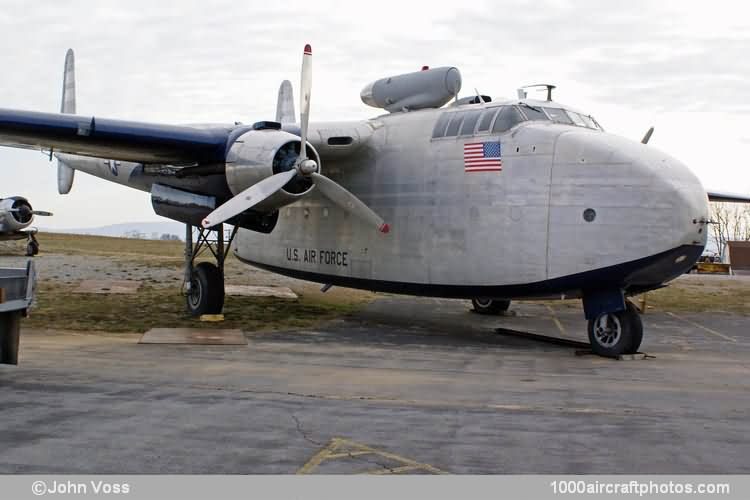01/31/2010. Remarks by Johan Visschedijk: "Fairchild undertook the design of a specialized military freighter to meet an USAAF requirement in 1941. The largest Fairchild project to date, this Model 78 was designed around the concept of a large, uninterrupted cargo hold, with direct access for loading at near ground level.
To achieve the latter, a twin boom layout was adopted, with the wing mounted high on the deep fuselage, which ended in clam-shell doors at the rear providing for straight-in loading of vehicles up ramps, or of freight from trucks at the same height as the fuselage floor. The fuselage cross section was adequate for trucks, howitzers, half-tracks, tanks and other Army vehicles. Two 2,100 hp Pratt & Whitney R-2800-85 radial engines provided power.
The F-78 design and a mockup were approved in 1942 and a contract for one prototype designated XC-82 was placed. This aircraft (s/n 43-13202) flew on September 10, 1944, by which time Fairchild had received a contract for 100 C-82A Packets. Deliveries began at the end of 1945, and intensive service tests followed, to prove new features of the design including a wing and tail de-icing system using hot air, and to develop suitable operating technique.
For air-dropping of vehicles and other large items, the rear fuselage doors were removed completely and a system was developed in which a drogue parachute was deployed and used to draw the vehicle out of the rear of the hold, after which the main parachute cluster was opened. For para-trooping, with 42 troops, small doors in each side of the rear fuselage were used. The C-82 could carry 34 stretchers, and was suitable for glider towing: in trials early in 1946, a Waco CG-15 and a Waco CG-4A were towed simultaneously.
In 1945, Fairchild received a contract for another 100 C-82As and North American Aviation was asked by the USAF to undertake production also. A second production line was laid down at Dallas and work began on a contract for 792 Packets similar to the Fairchild model and designated C-82N. Only three of these were completed, however, before this contract was cancelled after VJ Day. Fairchild eventually built 220 Packets and deliveries ended in September, 1948.
The C-82s were assigned to Troop Carrier squadrons of TAC in 1946 and subsequently some were also allocated to MATS. Five were assigned to the Berlin Air Lift, primarily to carry vehicles into the city. One aircraft (s/n 45-57746) was tested with Firestone tracked landing gear units, and was designated EC-82A. The Packet was declared obsolete in 1954.
The pictured aircraft was delivered to the USAF on March 26, 1948, with s/n 45-57814. It served for six years till it was struck off charge on July 1954. It came on the civil registry on June 30, 1955, registered as N2047A to Aerodex of Miami, Florida. It changed hands twice before it was registered to Trans World Airlines (TWA) on April 14, 1956. It was converted into a flying repair station at Orly Airport, Paris France, which became its home base for sixteen years servicing TWA's airliner fleet on European sectors.
Given fleet number 5551and named Ontos (Greek for Thing), it was usually flown by the French pilot Claude Girard. It was briefly registered in Ethiopia registered as ET-T-12 from February 2 to March 1, 1960, after which it was reregistered N9701F. In 1963 it was fitted with a 3,400 lb (1,542 kg) st Steward-Davis J34-WE-36 auxiliary turbojet in a pod over the center fuselage. In this configuration it served TWA another ten years till it was withdrawn from use in the early seventies.
From January 30, 1973 it had ten different owners/operators till it was obtained by the Hagerstown Aviation Museum, Maryland, on August 30, 2006, where it is preserved."
